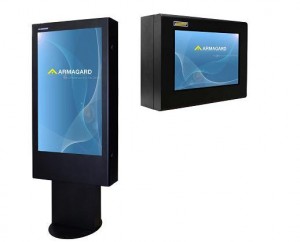Around shopping malls, airports and other high footfall locations, digital signage screens are a common sight. Many indoor digital signage displays systems have similarities; often positioned in portrait mode and ranging from 32 to 36 inches.

But when taking a screen outdoors, is this same size range and orientation, just as suitable?
Surprisingly, very little research has been done as to what orientation and size range works best, either in indoor or outdoor areas. However, what limited research there is, has provided some interesting results
While most indoor screens are in the portrait mode, research has indicated that landscape screens receive better recall from viewers, which is contrary to most digital signage applications.
And this is even more important for outdoor areas because an audience views outdoor digital signage slightly differently to indoor screens. First of all, dwell time on an outdoor screen is a lot lower than screens viewed indoors.
While an audience may spend up to eight seconds viewing an indoor display, outdoors, the times is far less, and even lower in inclement weather.
But dwell time isn’t the only difference. The distance the screen is viewed differs in outdoor digital signage compared to indoor. An audience typically views an outdoor screen from farther away and not just from passersby, but also commuters travelling in cars and on public transport passing by.
Because of the distance and dwell time differences, outdoor digital signage is more effective with larger screens compared to the average 32 to 36 inch used in indoor environments. Content such as text needs also to be larger and bolder, to take into account the distance and brief time an audience’s eyes linger on the display.
Because of all these factors, for outdoor digital signage, a landscape screen, over 36 inches, with bold, simple content is going to be more effective than smaller portrait varieties.
Comments are closed.